Leadership and Power: Theories, Styles, and Applications
VerifiedAdded on 2020/03/23
|6
|1353
|354
Essay
AI Summary
This essay delves into the multifaceted concepts of leadership and power within organizational contexts. It begins by highlighting the evolving landscape of project management, where leaders must balance managerial tasks with stakeholder relations and resource efficiency. The essay then explores three primary leadership styles: situational, transactional, and transformational. Situational leadership is presented as a flexible approach that adapts to different circumstances and employee competencies. Transactional leadership is characterized by a system of rewards and punishments based on performance, while transformational leadership emphasizes empowering team members and fostering a shared vision. The essay examines the strengths and weaknesses of each style, providing insights into their practical applications and implications for team dynamics and organizational success. The author provides a detailed analysis of how leaders exercise power to achieve organizational goals, emphasizing the importance of positive leadership practices that enhance output and foster a collaborative environment. Reference list is included.
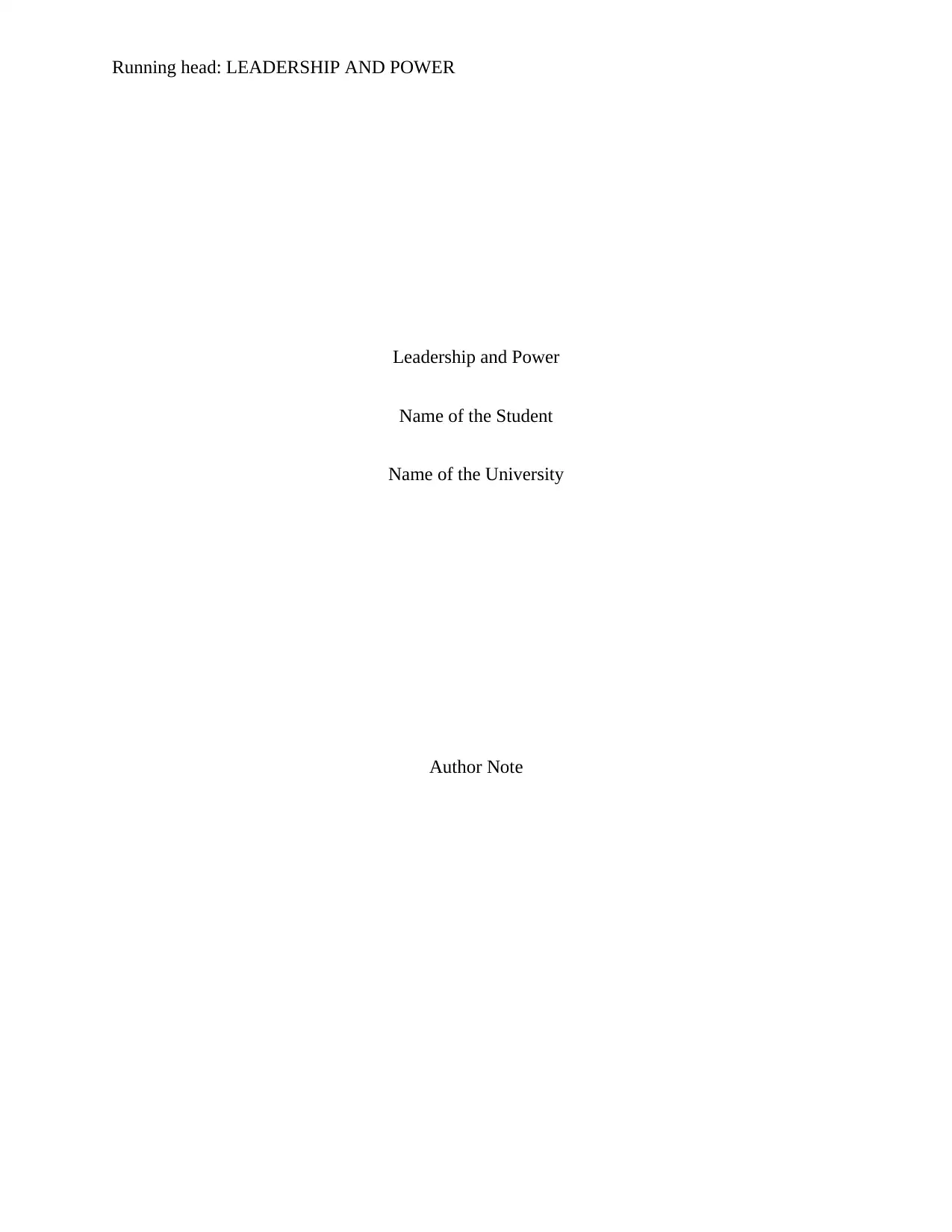
Running head: LEADERSHIP AND POWER
Leadership and Power
Name of the Student
Name of the University
Author Note
Leadership and Power
Name of the Student
Name of the University
Author Note
Paraphrase This Document
Need a fresh take? Get an instant paraphrase of this document with our AI Paraphraser
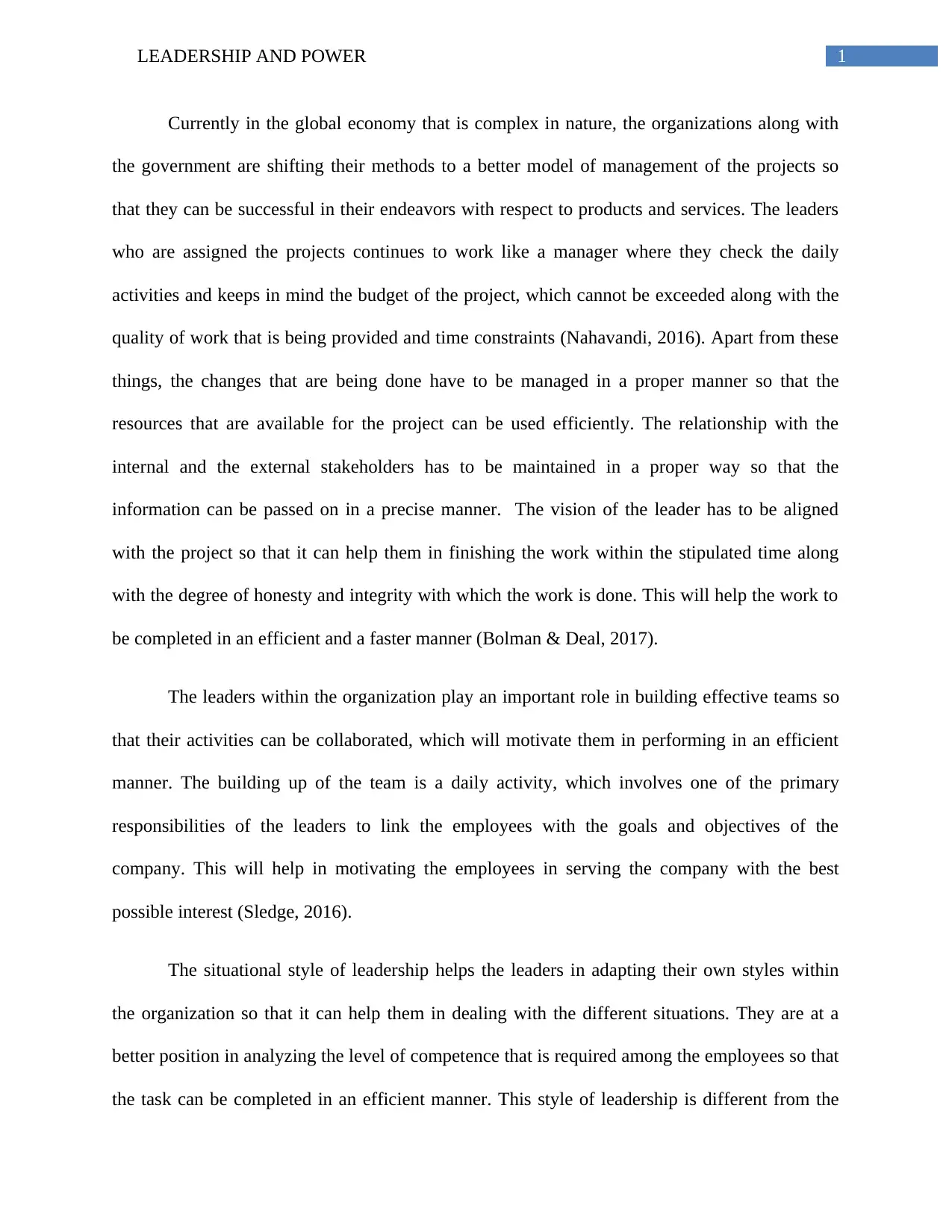
1LEADERSHIP AND POWER
Currently in the global economy that is complex in nature, the organizations along with
the government are shifting their methods to a better model of management of the projects so
that they can be successful in their endeavors with respect to products and services. The leaders
who are assigned the projects continues to work like a manager where they check the daily
activities and keeps in mind the budget of the project, which cannot be exceeded along with the
quality of work that is being provided and time constraints (Nahavandi, 2016). Apart from these
things, the changes that are being done have to be managed in a proper manner so that the
resources that are available for the project can be used efficiently. The relationship with the
internal and the external stakeholders has to be maintained in a proper way so that the
information can be passed on in a precise manner. The vision of the leader has to be aligned
with the project so that it can help them in finishing the work within the stipulated time along
with the degree of honesty and integrity with which the work is done. This will help the work to
be completed in an efficient and a faster manner (Bolman & Deal, 2017).
The leaders within the organization play an important role in building effective teams so
that their activities can be collaborated, which will motivate them in performing in an efficient
manner. The building up of the team is a daily activity, which involves one of the primary
responsibilities of the leaders to link the employees with the goals and objectives of the
company. This will help in motivating the employees in serving the company with the best
possible interest (Sledge, 2016).
The situational style of leadership helps the leaders in adapting their own styles within
the organization so that it can help them in dealing with the different situations. They are at a
better position in analyzing the level of competence that is required among the employees so that
the task can be completed in an efficient manner. This style of leadership is different from the
Currently in the global economy that is complex in nature, the organizations along with
the government are shifting their methods to a better model of management of the projects so
that they can be successful in their endeavors with respect to products and services. The leaders
who are assigned the projects continues to work like a manager where they check the daily
activities and keeps in mind the budget of the project, which cannot be exceeded along with the
quality of work that is being provided and time constraints (Nahavandi, 2016). Apart from these
things, the changes that are being done have to be managed in a proper manner so that the
resources that are available for the project can be used efficiently. The relationship with the
internal and the external stakeholders has to be maintained in a proper way so that the
information can be passed on in a precise manner. The vision of the leader has to be aligned
with the project so that it can help them in finishing the work within the stipulated time along
with the degree of honesty and integrity with which the work is done. This will help the work to
be completed in an efficient and a faster manner (Bolman & Deal, 2017).
The leaders within the organization play an important role in building effective teams so
that their activities can be collaborated, which will motivate them in performing in an efficient
manner. The building up of the team is a daily activity, which involves one of the primary
responsibilities of the leaders to link the employees with the goals and objectives of the
company. This will help in motivating the employees in serving the company with the best
possible interest (Sledge, 2016).
The situational style of leadership helps the leaders in adapting their own styles within
the organization so that it can help them in dealing with the different situations. They are at a
better position in analyzing the level of competence that is required among the employees so that
the task can be completed in an efficient manner. This style of leadership is different from the
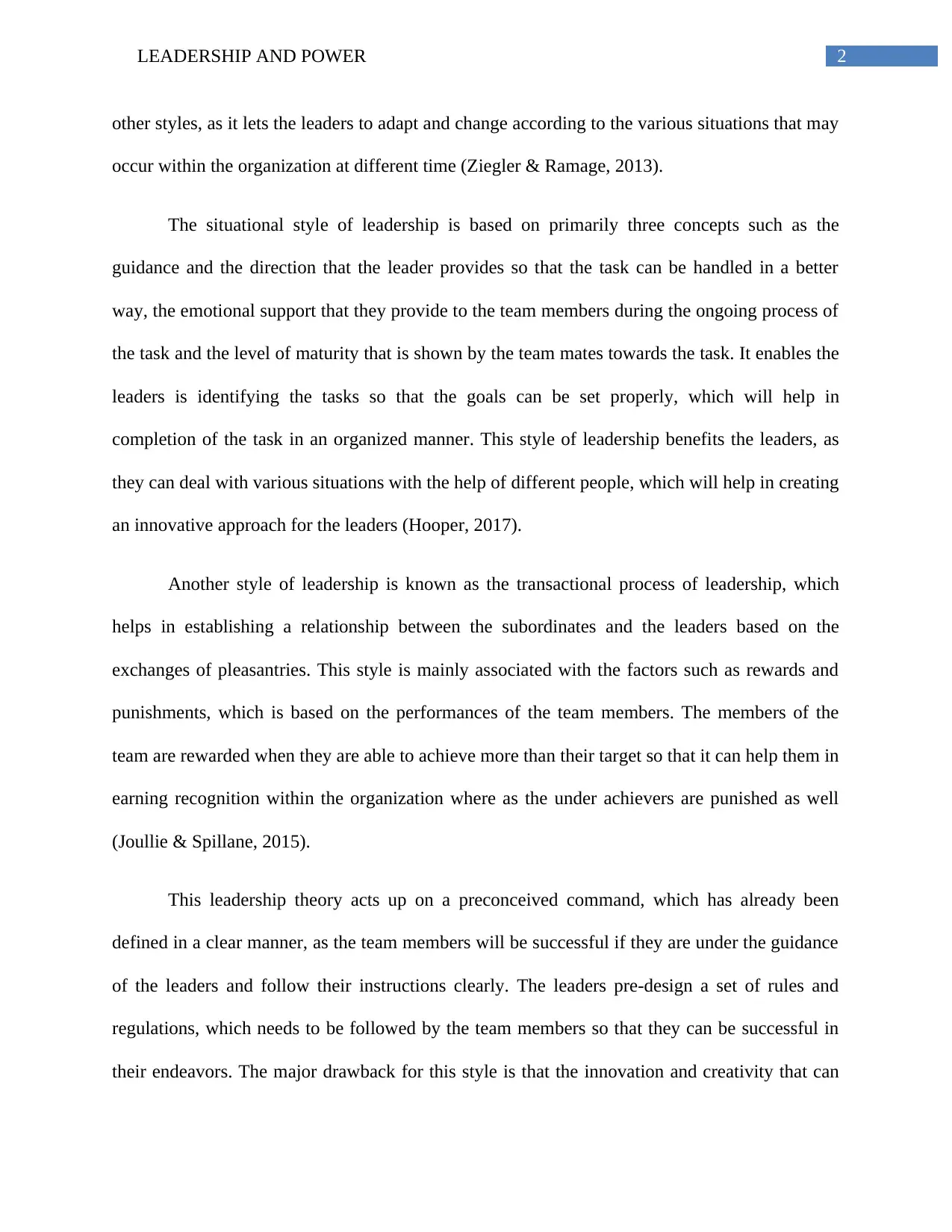
2LEADERSHIP AND POWER
other styles, as it lets the leaders to adapt and change according to the various situations that may
occur within the organization at different time (Ziegler & Ramage, 2013).
The situational style of leadership is based on primarily three concepts such as the
guidance and the direction that the leader provides so that the task can be handled in a better
way, the emotional support that they provide to the team members during the ongoing process of
the task and the level of maturity that is shown by the team mates towards the task. It enables the
leaders is identifying the tasks so that the goals can be set properly, which will help in
completion of the task in an organized manner. This style of leadership benefits the leaders, as
they can deal with various situations with the help of different people, which will help in creating
an innovative approach for the leaders (Hooper, 2017).
Another style of leadership is known as the transactional process of leadership, which
helps in establishing a relationship between the subordinates and the leaders based on the
exchanges of pleasantries. This style is mainly associated with the factors such as rewards and
punishments, which is based on the performances of the team members. The members of the
team are rewarded when they are able to achieve more than their target so that it can help them in
earning recognition within the organization where as the under achievers are punished as well
(Joullie & Spillane, 2015).
This leadership theory acts up on a preconceived command, which has already been
defined in a clear manner, as the team members will be successful if they are under the guidance
of the leaders and follow their instructions clearly. The leaders pre-design a set of rules and
regulations, which needs to be followed by the team members so that they can be successful in
their endeavors. The major drawback for this style is that the innovation and creativity that can
other styles, as it lets the leaders to adapt and change according to the various situations that may
occur within the organization at different time (Ziegler & Ramage, 2013).
The situational style of leadership is based on primarily three concepts such as the
guidance and the direction that the leader provides so that the task can be handled in a better
way, the emotional support that they provide to the team members during the ongoing process of
the task and the level of maturity that is shown by the team mates towards the task. It enables the
leaders is identifying the tasks so that the goals can be set properly, which will help in
completion of the task in an organized manner. This style of leadership benefits the leaders, as
they can deal with various situations with the help of different people, which will help in creating
an innovative approach for the leaders (Hooper, 2017).
Another style of leadership is known as the transactional process of leadership, which
helps in establishing a relationship between the subordinates and the leaders based on the
exchanges of pleasantries. This style is mainly associated with the factors such as rewards and
punishments, which is based on the performances of the team members. The members of the
team are rewarded when they are able to achieve more than their target so that it can help them in
earning recognition within the organization where as the under achievers are punished as well
(Joullie & Spillane, 2015).
This leadership theory acts up on a preconceived command, which has already been
defined in a clear manner, as the team members will be successful if they are under the guidance
of the leaders and follow their instructions clearly. The leaders pre-design a set of rules and
regulations, which needs to be followed by the team members so that they can be successful in
their endeavors. The major drawback for this style is that the innovation and creativity that can
⊘ This is a preview!⊘
Do you want full access?
Subscribe today to unlock all pages.

Trusted by 1+ million students worldwide
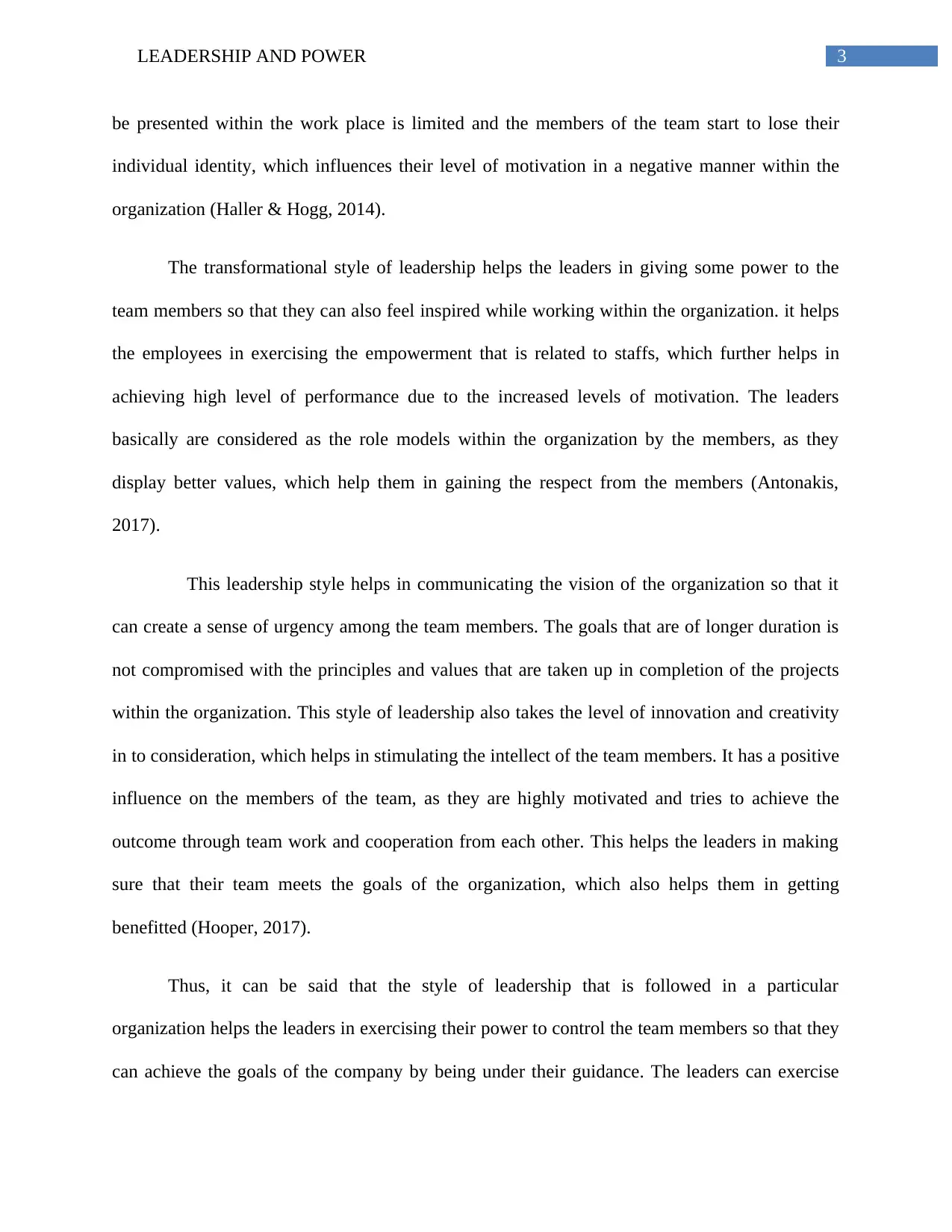
3LEADERSHIP AND POWER
be presented within the work place is limited and the members of the team start to lose their
individual identity, which influences their level of motivation in a negative manner within the
organization (Haller & Hogg, 2014).
The transformational style of leadership helps the leaders in giving some power to the
team members so that they can also feel inspired while working within the organization. it helps
the employees in exercising the empowerment that is related to staffs, which further helps in
achieving high level of performance due to the increased levels of motivation. The leaders
basically are considered as the role models within the organization by the members, as they
display better values, which help them in gaining the respect from the members (Antonakis,
2017).
This leadership style helps in communicating the vision of the organization so that it
can create a sense of urgency among the team members. The goals that are of longer duration is
not compromised with the principles and values that are taken up in completion of the projects
within the organization. This style of leadership also takes the level of innovation and creativity
in to consideration, which helps in stimulating the intellect of the team members. It has a positive
influence on the members of the team, as they are highly motivated and tries to achieve the
outcome through team work and cooperation from each other. This helps the leaders in making
sure that their team meets the goals of the organization, which also helps them in getting
benefitted (Hooper, 2017).
Thus, it can be said that the style of leadership that is followed in a particular
organization helps the leaders in exercising their power to control the team members so that they
can achieve the goals of the company by being under their guidance. The leaders can exercise
be presented within the work place is limited and the members of the team start to lose their
individual identity, which influences their level of motivation in a negative manner within the
organization (Haller & Hogg, 2014).
The transformational style of leadership helps the leaders in giving some power to the
team members so that they can also feel inspired while working within the organization. it helps
the employees in exercising the empowerment that is related to staffs, which further helps in
achieving high level of performance due to the increased levels of motivation. The leaders
basically are considered as the role models within the organization by the members, as they
display better values, which help them in gaining the respect from the members (Antonakis,
2017).
This leadership style helps in communicating the vision of the organization so that it
can create a sense of urgency among the team members. The goals that are of longer duration is
not compromised with the principles and values that are taken up in completion of the projects
within the organization. This style of leadership also takes the level of innovation and creativity
in to consideration, which helps in stimulating the intellect of the team members. It has a positive
influence on the members of the team, as they are highly motivated and tries to achieve the
outcome through team work and cooperation from each other. This helps the leaders in making
sure that their team meets the goals of the organization, which also helps them in getting
benefitted (Hooper, 2017).
Thus, it can be said that the style of leadership that is followed in a particular
organization helps the leaders in exercising their power to control the team members so that they
can achieve the goals of the company by being under their guidance. The leaders can exercise
Paraphrase This Document
Need a fresh take? Get an instant paraphrase of this document with our AI Paraphraser

4LEADERSHIP AND POWER
their power in a positive manner, which will be beneficial for the organization as well, as the
output will increase to a large extent.
their power in a positive manner, which will be beneficial for the organization as well, as the
output will increase to a large extent.
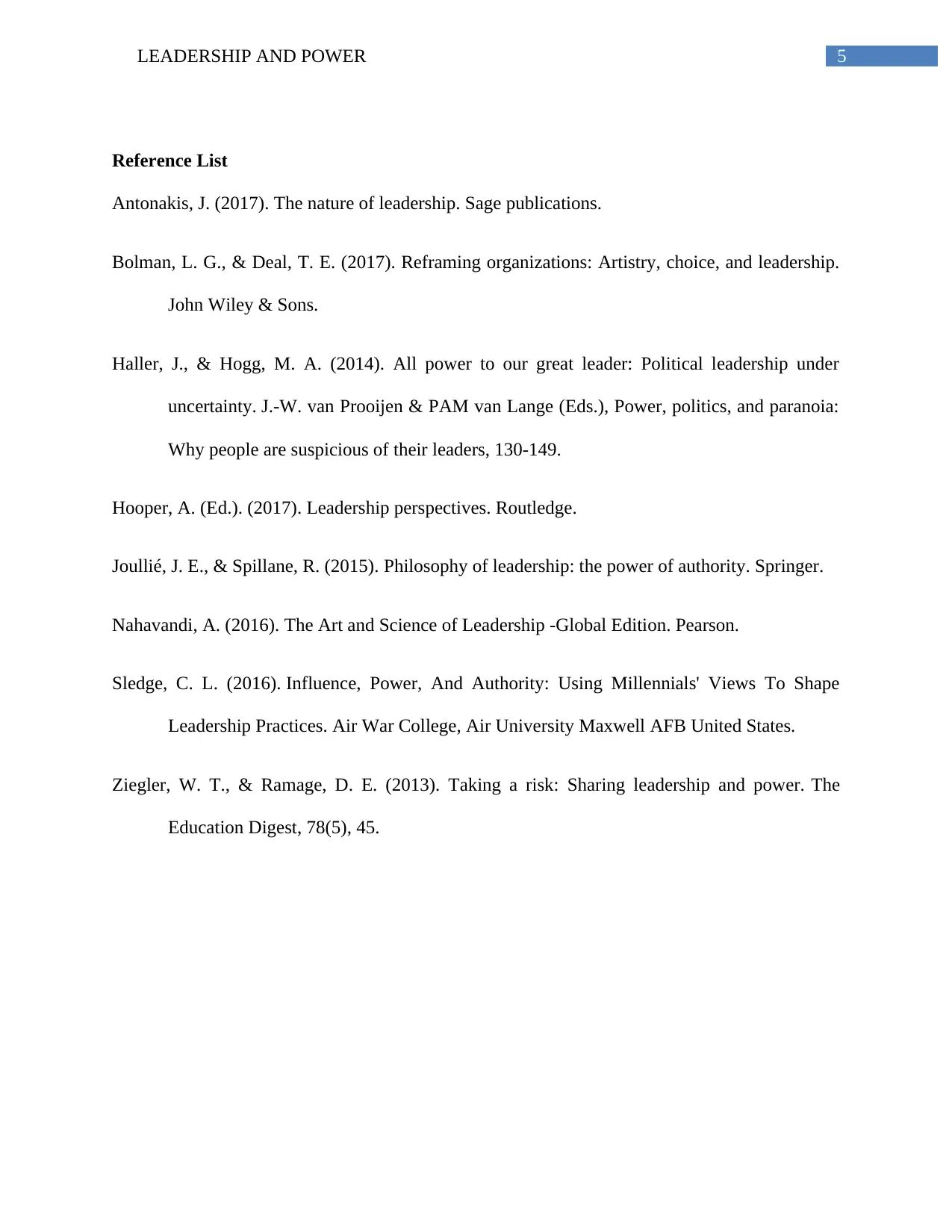
5LEADERSHIP AND POWER
Reference List
Antonakis, J. (2017). The nature of leadership. Sage publications.
Bolman, L. G., & Deal, T. E. (2017). Reframing organizations: Artistry, choice, and leadership.
John Wiley & Sons.
Haller, J., & Hogg, M. A. (2014). All power to our great leader: Political leadership under
uncertainty. J.-W. van Prooijen & PAM van Lange (Eds.), Power, politics, and paranoia:
Why people are suspicious of their leaders, 130-149.
Hooper, A. (Ed.). (2017). Leadership perspectives. Routledge.
Joullié, J. E., & Spillane, R. (2015). Philosophy of leadership: the power of authority. Springer.
Nahavandi, A. (2016). The Art and Science of Leadership -Global Edition. Pearson.
Sledge, C. L. (2016). Influence, Power, And Authority: Using Millennials' Views To Shape
Leadership Practices. Air War College, Air University Maxwell AFB United States.
Ziegler, W. T., & Ramage, D. E. (2013). Taking a risk: Sharing leadership and power. The
Education Digest, 78(5), 45.
Reference List
Antonakis, J. (2017). The nature of leadership. Sage publications.
Bolman, L. G., & Deal, T. E. (2017). Reframing organizations: Artistry, choice, and leadership.
John Wiley & Sons.
Haller, J., & Hogg, M. A. (2014). All power to our great leader: Political leadership under
uncertainty. J.-W. van Prooijen & PAM van Lange (Eds.), Power, politics, and paranoia:
Why people are suspicious of their leaders, 130-149.
Hooper, A. (Ed.). (2017). Leadership perspectives. Routledge.
Joullié, J. E., & Spillane, R. (2015). Philosophy of leadership: the power of authority. Springer.
Nahavandi, A. (2016). The Art and Science of Leadership -Global Edition. Pearson.
Sledge, C. L. (2016). Influence, Power, And Authority: Using Millennials' Views To Shape
Leadership Practices. Air War College, Air University Maxwell AFB United States.
Ziegler, W. T., & Ramage, D. E. (2013). Taking a risk: Sharing leadership and power. The
Education Digest, 78(5), 45.
⊘ This is a preview!⊘
Do you want full access?
Subscribe today to unlock all pages.

Trusted by 1+ million students worldwide
1 out of 6
Related Documents
Your All-in-One AI-Powered Toolkit for Academic Success.
+13062052269
info@desklib.com
Available 24*7 on WhatsApp / Email
![[object Object]](/_next/static/media/star-bottom.7253800d.svg)
Unlock your academic potential
Copyright © 2020–2025 A2Z Services. All Rights Reserved. Developed and managed by ZUCOL.




